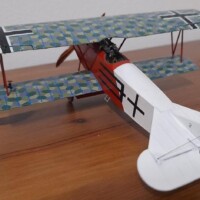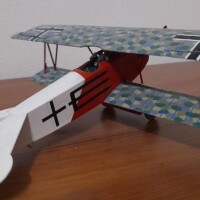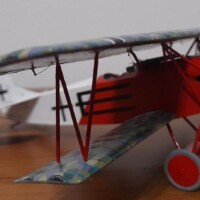Fokker D VII, (Alb. late), Eduard, 1:48, Ltn Josef Raesch. Jasta 43, 7 victories
So, before the end of the year, I will have time to add one more model. Another addition to the Fokker collection. Again, a very pleasant build, without any major tricks.
Leutnant Josef Raesch was a World War I flying ace with seven aerial victories. Two of his wins were over fellow aces, Guy Wareing and Ernest Charles Hoy.
After training, he was assigned to the reconnaissance unit Flieger-Abteilung (Flier Detachment) 7 as a two-seat pilot. After shooting there, he attended Jastaschule (fighter pilot training) followed by a posting to a fighter squadron. He joined Jagdstaffel 43 on 6 June 1918. He reported in his June diary that rookie pilots posted to the squadron were given the older Albatros D.III or Albatros D.V to fly, but that the newer Fokker D.VIIs were filtering into the unit. The eighth arrival of D.VII is recorded. Raesch inherited a Fokker D.VII from Otto Creutzmann when he left Jasta on 13 June. Creutzmann's insignia of a pitchfork sticking forward remained on the plane.
For his first aerial victory, Raesch shot down a Royal Aircraft Factory SE.5a north of Hantay at 11:00 on 27 June 1918. On 1 July he scored again, shooting down a Sopwith Camel. A week later he shot down another SE.5a over Nieppe Wood for his third confirmed victory. On July 25, he lost the fight at 6:00 p.m.; Lt. Ivan Frank Hind flying SE.5a C5358 shot down Raesch in flames using a Buckingham incendiary munition. The bullets narrowly missed Raesch's head, but a burst of flame hit him in the face. Although Raesch had only had a parachute for the past fortnight, during one of the pioneering wartime jumps it collapsed and hit the ground alive, but with a burnt face. To do so, he had to rip his chute out of the container in mid-air. Then a two-meter hole burned the chute. The chute was repaired and reissued to save the life of another pilot. He was the first pilot to use a parachute in combat. Raesch did not score again until 17:50 on 28 September 1918 when he shot down Flight Commander Ernest Charles Hoy of No. 29 Squadron RAF. Flying ace Hoy survived the crash of his Royal Aircraft Factory SE.5a east of Ypres, but was captured by German ground troops.
Raesch did not score again until 26 October when he shot down an SE.5a over Velennes, France. At 10:30 the following day, he shot down another flight commander from No. 29 Squadron, Captain Guy Wareing. Wareing's body and wreckage landed east of Tournai.
Nothing further is known about Josef Raesch, except that as late as 1967 he was known to have worked as a machine tool manufacturer.









Nice work on this model and an excellent result. Also interesting history I didn't know about. First pilot to save his life with a parachute - interesting!
Thank you Friend.
Another excellent result and really amazing story, Milan! First successful parachute deployment in combat: outstanding!
Thank you Friend.
Well done, Milan!
Thank you Gary.
Great history lesson to go along with a great model. Beautiful work Rafi, as always. I wasn't aware of this interesting story either, thanks for sharing.
Thank you Clint.
Very nice build. @milantesar
Thank you John.
Interesting story and another great model to add to your collection.
Thank you George.
Excellent model and a very interesting story to go with it. You obviously have done your research Milan.
Thank you Ian.
Excellent result, Milan @milantesar
Great story as well, still must have been a challenging task to get out of that cockpit and get the parachute deployed.
Thanks John, yes the first parachute jumps from a damaged plane must have been a great adrenaline rush.
Great modelling with an equally good read Milan. 👍
Thank you Guy.
Very nice, Milan. You’re inspiring me to pull some WW1 kits out of the stash for next year.
Thanks John, I'm glad to be an inspiration and I'm already looking forward to your first war.
You really find some great schemes to add to your builds - another looker!
Děkuji Greg, I still have three more to build.
Great D VII build and interesting history behind it.